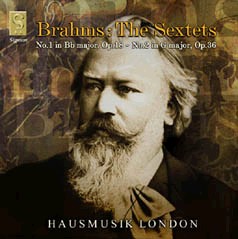|
|
World music CD DVD shop and Classic distribution
|
|
|
|
| BRAHMS, Johannes (1833-1897) | | | No.1 in Bb major, Op.18 | | | 1. | Allegro, ma non troppo | 13:53 | | | 2. | Andante, ma moderato | 9:28 | | | 3. | Scherzo, Allegro molto | 3:00 | | | 4. | Rondo: Poco allegretto e grazioso | 10:01 | | | No.2 in G major, Op.36 | | | 5. | Allegro non troppo | 14:43 | | | 6. | Scherzo: Allegro non troppo | 7:05 | | | 7. | Poco adagio | 8:52 | | | 8. | Poco allegro | 8:37 | | Gramophone Early Music - Autumn 1999
In the G major Sextet, op.36, Hausmusik easily surpasses the previous period-instrument recording (L'Archibudelli; Sony Classical). The difference is obvious from the opening melody. L'Archibudelli's Vera Beths cuts off long notes in a quasi-baroque manner that lacks strong historical support and is, to my ears, musically unsatisfying. By contrast, Hausmusik's Monica Huggett shapes the long notes (and the larger phrases) beautifully. She does not, in the process, ignore articulation marks; indeed, she makes better sense of them that Beths does.
In general Hausmusik's performance stands comparison with any recording I've heard of this work. The second thematic group lilts and swings, building to a stirring climax; the upper strings do full justice to the third-movement opening, with its richly inflected harmonies and deeply felt emotion; and similar examples could fill the rest of this column.
In Op.18, on the other hand, while Hausmusik's playing is very fine, L'Archibudelli's is preferable. The latter group integrates its highly detailed articulation more convincingly than it did in Op.36. In the theme of the Op.18 Andante, for example, L'Archibudelli makes sense of the staccato marks, which Hausmusik more or less ignores. L'Archibudelli's performance of the movement has significantly higher voltage in general (generated in part, perhaps, by a faster tempo).
L'Archibudelli also has an advantage in the first movement. Brahms put the word animato under the new theme at b.84, and both ensembles agree (correctly, I believe) that it implies a tempo increase. But how big an increase? That of Hausmusik is the largest I've ever heard, and takes some getting used to, although the effect is passionate and one's ears adjust. No adjustment is needed for L'Archibudelli, however. It picks up the tempo less drastically, but with even more memorable results. These performers make the entry of the new melody feel like a swelling of passion from within the previous musical stream, rather than like a shift to a higher gear.
I must emphasise, however, that there is much to admire in Hausmusik's Op.18, even if the comparison this time favours the competition.
Potential buyers making a choice between the two recordings may want to consider the sound quality: that on the Hausmusik disc is clearer and reveals more detail, an advantage in these richly scored masterpieces. Again, though, the disc deserves attention for the performances themselves, especially that of Op.36.
Bernard D.Sherman
Early Music Review - October 1999
Hausmusik's recordings of the early Romantic repertoire are now well known. It is gratifying that they are now venturing into the later 19th century. As a schoolboy, I clearly remember asking for a violin E string in a music shop, and getting the response, 'Gut or metal, sir?' It is to be hoped that it will not be long before we regain that position in the string world; for the earthiness of gut strings is clearly evident, not least in the remarkable andante variations of the Bb sextet (surely inspired by the Bach D minor Chaconne, which he later arranged for piano) with its multiple stopping and chaconne-like bass line, where the immense D minor sonorities contrast with the pianissimo of the almost vibrato-less flute-like D major section. The drive and precision of the ensemble are shown in the stunning finale's coda. Although I find the G major work the less satisfying of the two, it is immaculate in its detail and its purity of intonation. For those who like their Brahms free of cloying continuous vibrato and the often sharp notes of many modern string players, this is undoubtedly the recording to choose.
Ian Graham-Jones
BBC Music Magazine - September 1999
|
|

